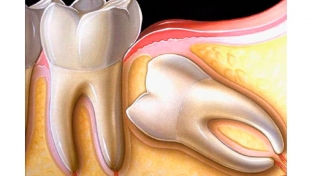Incorrect position of the tooth in the dentition is called dystopia. A dystopian tooth may be displaced beyond the alveolar process of the jaw. This position of the tooth makes it difficult for the eruption and growth of neighboring teeth, and in addition, creates a significant cosmetic defect. More often, the dystopic tooth is the third molar (“wisdom tooth”), upper and lower canines.
Tooth dystopia develops against the background of exogenous, genetic and embryonic factors. Treatment of a dystopic tooth depends on the degree of influence on the oral mucosa and the severity of the cosmetic defect.
Main causes of dystopic tooth growth
One of the common causes of dental dystopia is the incorrect formation of tooth rudiments during embryogenesis. Dystopia appears with a sharp violation of the proportion of the size of milk and permanent teeth, with early removal of temporary teeth, with partial adentia, as well as with a violation of the sequence and timing of teething.
If the size of a person's jaw does not match the size of their teeth, dystopic teeth may also appear. This occurs in children who inherit large teeth from one parent and a small jaw from the other parent.
Among exogenous factors, a traumatic cause is distinguished. If the position of the tooth is partially changed, and the connection with the hole is preserved, we are talking about incomplete dystopia. With a complete displacement of the tooth outside the socket, in conditions of holding the tooth by soft tissues, the process is regarded as a complete tooth dystopia.
Quite often dystopic teeth are fangs and wisdom teeth. Why exactly these teeth, knows estet-portal.com. This is due to the fact that by the time the canines appear in the dentition, there is no longer room for them in the dentition, which makes them grow in the wrong place. Wisdom teeth are often dystopic due to the fact that they have no predecessors, and they themselves have to grow through the bone tissue.
Dystopic tooth placement options:
- vestibular;
- distal location;
- oral;
- mesial;
- superposition;
- infralocation;
- transposition;
- tortoposition.

Possible effects of a dystopic tooth on oral tissues
A dystopic tooth brings, in addition to aesthetic problems, functional disorders. In some cases, a dystopian tooth may be in the body or branch of the lower jaw, in the wall of the nasal cavity, the orbit or in the hard palate.
A dystopian tooth interferes with normal teething, which contributes to the development of malocclusion. In addition, a dystopic tooth damages and injures the tissues of the lips, tongue and cheeks, which ends in the formation of decubital ulcers.
A dystopic tooth does not allow adequate oral hygiene, the removal of food residues and plaque. Gingival pockets often form over the erupted portion of dystopic and impacted teeth. Microorganisms and food debris accumulate in them, which lead to the development of the inflammatory process and pericoronitis.
When is extraction of a dystopic tooth not necessary?
If a dystopic tooth does not pose a serious functional and aesthetic problem, but only contributes to permanent traumatization of the oral mucosa, then sharp tubercles are polished. If a place is found for a dystopian tooth in the dental arch, orthodontic treatment is carried out.
In all other cases, the preference in treatment is given to the surgical removal of the dystopic tooth. Also, in the presence of jaw cysts, the presence of difficulties with prosthetics or the treatment of caries of 7 teeth, osteomyelitis, periodontitis, the removal of a dystopian tooth is indicated.







Add a comment